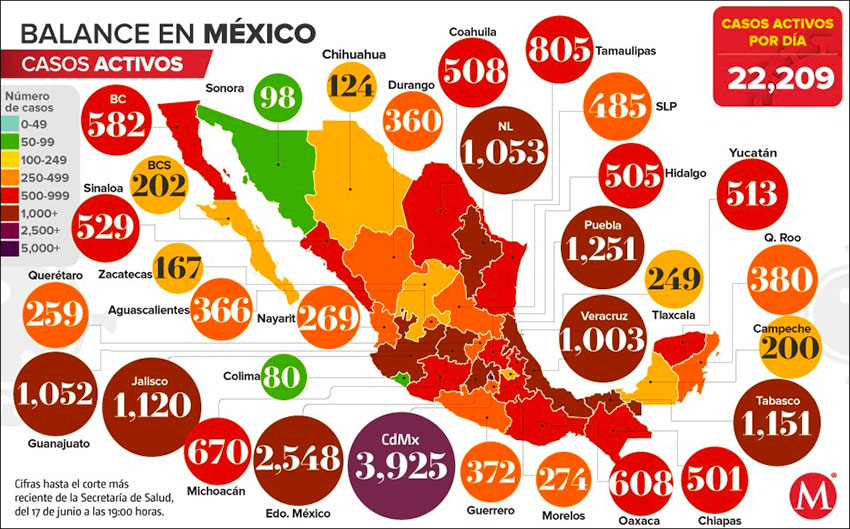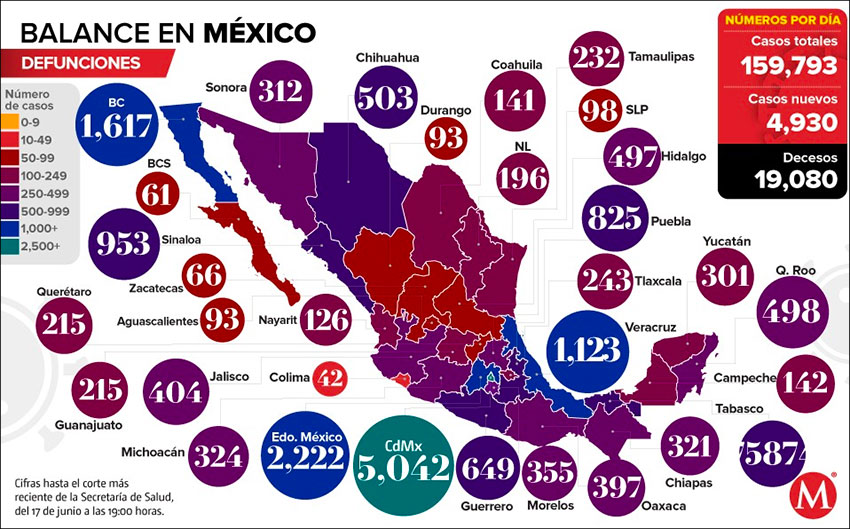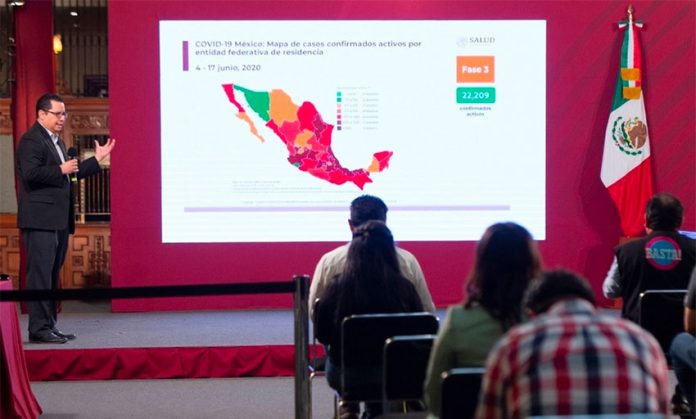Among the 20 countries currently most affected by Covid-19, Mexico is one of 15 that has not had success in flattening the epidemic curve, according to an analysis by Johns Hopkins University.
The university’s analysis shows that daily confirmed case numbers are trending upwards in Mexico, Brazil, the United States, India, Peru, Chile, Pakistan, Egypt, South Africa, Colombia, Iraq, Indonesia, Bangladesh, Ecuador and Saudi Arabia.
In contrast, daily case numbers are decreasing in Russia, the United Kingdom, Iran, Italy and Canada.
Since the beginning of the pandemic in Mexico, the Health Ministry has reported a total of 159,793 and 19,080 deaths. More than 4,000 new cases have been reported on six of the past 10 days and more than 5,000 cases were reported on one.
Both Deputy Health Minister Hugo López-Gatell, the government’s coronavirus point man, and President López Obrador have asserted that the epidemic curve has flattened in Mexico.

However, the former has explained that the assertion refers to a flattening of the curve in comparison with what would have hypothetically occurred had Mexico not implemented coronavirus mitigation measures such as the suspension of nonessential economic activities and the national social distancing initiative.
At the Health Ministry’s coronavirus press briefing on Wednesday night, López-Gatell presented the epidemic curves for several cities across the country.
He said the number of new cases reported daily has peaked in the Mexico City metropolitan area – the country’s coronavirus epicenter – but stressed that the epidemic is still very much active.
“The epidemic has not ended and those of us who live in the Valley of México, we’re 23% of the Mexican population, [need to] know that we still have significant epidemic activity,” López- Gatell said.
He said that about 4,60o coronavirus patients are currently hospitalized in the Mexico City metropolitan area, a figure that has remained steady for more than three weeks.
In Baja California, which has recorded the fourth highest number of cases among Mexico’s 32 states and the third highest Covid-19 death toll, new infections are declining in Tijuana, López-Gatell said, while state capital Mexicali is in a period of “intense transmission” due to a new outbreak.

The deputy minister said the epidemic curve in Cancún, Quintana Roo, where hotels reopened last week after being closed for more than two months, is trending downward and that new hospitalizations of Covid-19 patients are also declining, albeit slowly.
The pandemic has lasted longer than predicted in Culiacán, Sinaloa, while case numbers in Veracruz city reached higher levels than expected but are now on the wane, López-Gatell said.
Case numbers in Acapulco, Guerrero, also exceeded expectations but the epidemic curve is now showing signs of flattening, he said, adding that hospitals in the resort city remain under significant pressure.
The coronavirus epidemics in Guadalajara, Jalisco, and Monterrey, Nuevo León, are in a clear ascent phase, López-Gatell said, while new infections are declining in Oaxaca city.
Earlier in the press briefing, Director of Epidemiology José Luis Alomía reported 4,930 additional Covid-19 cases – the second highest number reported on a single day – and 770 deaths.
Of the almost 160,000 cases confirmed since the start of the pandemic, 22,209 – 14% of the total – are currently active. Alomía said that the results of more than 59,000 Covid-19 tests are not yet known and that more than 441,000 people have been tested.

He also said that there are 1,846 suspected Covid-19 fatalities in addition to the 19,080 that have been confirmed.
Mexico City’s official death toll passed 5,000 on Wednesday, although the real number of Covid-19 fatalities in the capital is believed to be much higher. More than a quarter of all coronavirus-related deaths in Mexico occurred in the capital, data shows.
Three states have death tolls above 1,000: México state, with 2,222 fatalities; Baja California, with 1,617; and Veracruz, with 1,123.
At the municipal level, the Mexico City boroughs of Iztapalapa and Gustavo A. Madero rank first and second, respectively, for deaths followed by the Baja California cities of Tijuana and Mexicali.
